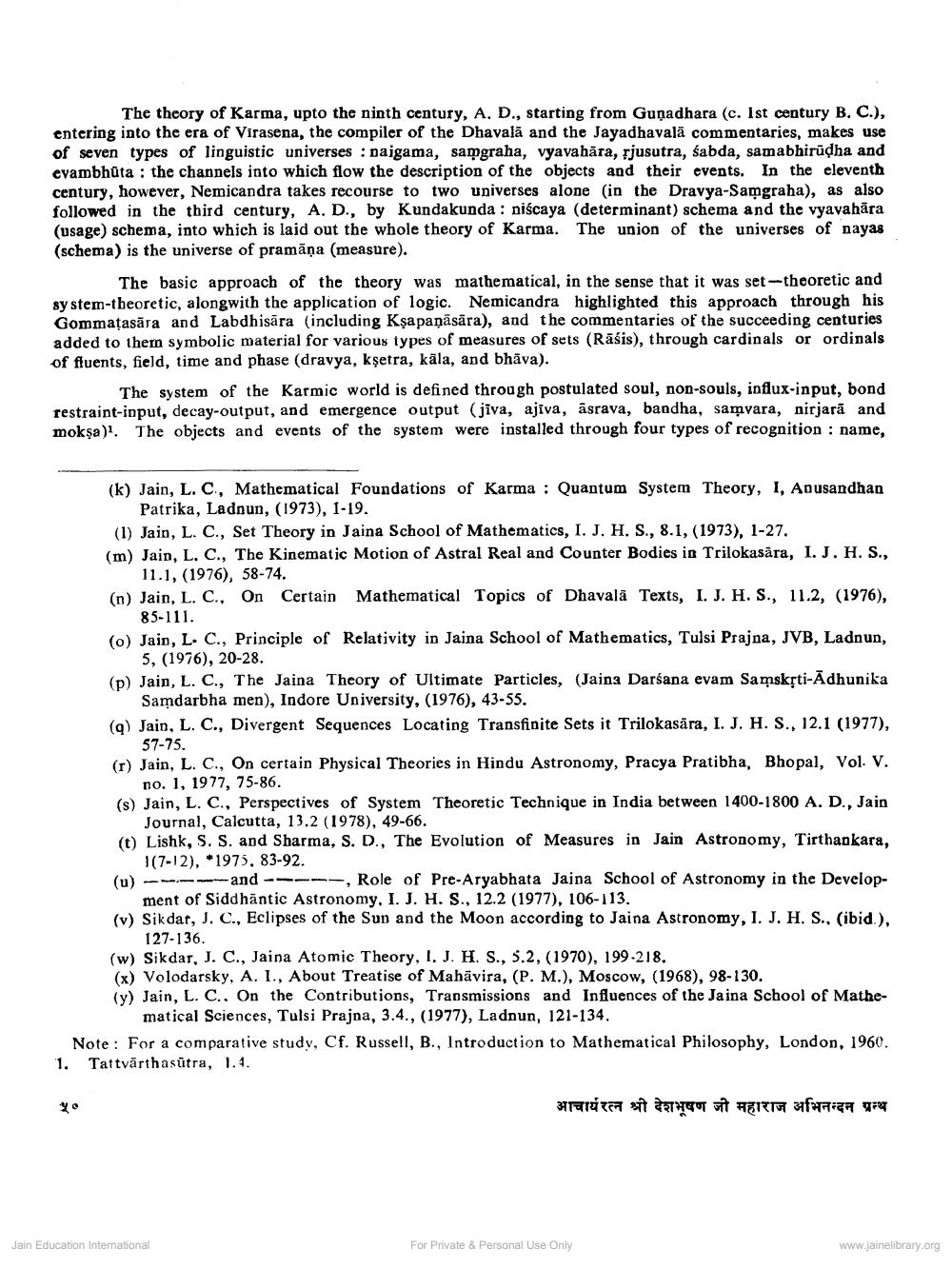Book Title: Jaina Ulterior Motive of Mathematical Philosophy Author(s): L C Jain, C K Jain Publisher: Z_Deshbhushanji_Maharaj_Abhinandan_Granth_012045.pdf View full book textPage 2
________________ The theory of Karma, upto the ninth century, A. D., starting from Gunadhara (c. Ist century B. C.), entering into the era of Virasena, the compiler of the Dhavalā and the Jayadhavalä сommentaries, makes use of seven types of linguistic universes : paigama, samgraha, vyavahāra, rjusutra, sabda, samabhirūdha and evambhūta : the channels into which flow the description of the objects and their events. In the eleventh century, however, Nemicandra takes recourse to two universes alone in the Dravya-Samgraha), as also followed in the third century, A. D., by Kundakunda : niscaya (determinant) schema and the vyavahāra (usage) schema, into which is laid out the whole theory of Karma. The union of the universes of nayas (schema) is the universe of pramäņa (measure). The basic approach of the theory was mathematical, in the sense that it was set theoretic and sy stem-theoretic, alongwith the application of logic. Nemicandra highlighted this approach through his Gommațasāra and Labdhisāra (including Kșapaņāsāra), and the commentaries of the succeeding centuries added to ther symbolic material for various types of measures of sets (Rašis), through cardinals or ordinals of fluents, field, time and phase (dravya, kşetra, käla, and bhäva). The system of the Karmic world is defined through postulated soul, non-souls, influx-input, bond restraint-input, decay-output, and emergence output (jiva, ajiva, asrava, bandha, samvara, nirjarā and mokşa)". The objects and events of the system were installed through four types of recognition : name, (k) Jain, L. C., Mathematical Foundations of Karma : Quantum System Theory, I, Aousandhan Patrika, Ladnun, (1973), 1-19. (1) Jain, L. C., Set Theory in Jaina School of Mathematics, I. J. H. S., 8.1, (1973), 1-27. (m) Jain, L. C., The Kinematic Motion of Astral Real and Counter Bodies in Trilokasära, I. J. H. S., 11.1, (1976), 58-74. (n) Jain, L. C., On Certain Mathematical Topics of Dhavalā Texts, I. J.H.S., 11.2, (1976), 85-111. (0) Jain, L. C., Principle of Relativity in Jaina School of Mathematics, Tulsi Prajna, JVB, Ladnun, 5, (1976), 20-28. (p) Jain, L. C., The Jaina Theory of Ultimate Particles, (Jaina Darsana evam Samsksti-Adhunika Samdarbha men), Indore University, (1976), 43-55. (9) Jain, L. C., Divergent Sequences Locating Transfinite Sets it Trilokasära, I. J. H. S., 12.1 (1977), 57-75. (1) Jain, L. C., On certain Physical Theories in Hindu Astronomy, Pracya Pratibha, Bhopal, Vol. V. no. 1, 1977, 75-86. (s) Jain, L. C., Perspectives of System Theoretic Technique in India between 1400-1800 A. D., Jain Journal, Calcutta, 13.2 (1978), 49-66. (t) Lishk, S. S. and Sharma, S. D., The Evolution of Measures in Jain Astronomy, Tirthaokara, 1(7-12), *1975, 83-92. (u) --- -and --- -, Role of Pre-Aryabhata Jaina School of Astronomy in the Develop ment of Siddhāntic Astronomy, I. J. H. S., 12.2 (1977), 106-113. (v) Sikdar, J. C., Eclipses of the Sun and the Moon according to Jaina Astronomy, 1. J. H. S., (ibid.), 127-136. (w) Sikdar, J. C., Jaina Atomic Theory, I. J. H. S., 5.2, (1970), 199-218. (x) Volodarsky, A. I., About Treatise of Mahāvira, (P. M.), Moscow, (1968), 98-130. (v) Jain, L. C.. On the Contributions, Transmissions and Influences of the Jaina School of Mathe matical Sciences, Tulsi Prajna, 3.4., (1977), Ladnun, 121-134. Note: For a comparative study, Cf. Russell, B., Introduction to Mathematical Philosophy, London, 1960. 1. Tattvārthasūtra, 1.4. आचार्य रत्न श्री देशभूषण जी महाराज अभिनन्दन ग्रन्थ Jain Education International For Private & Personal Use Only www.jainelibrary.orgPage Navigation
1 2 3 4 5 6 7 8 9 10 11
